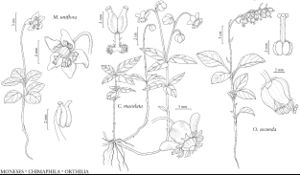Chimaphila
Fl. Amer. Sept. 1: 279, 300. 1813 ,.
Subshrubs, chlorophyllous, autotrophic. Stems erect, rarely decumbent, glabrous or papillose to hispidulous, especially distally. Leaves cauline, alternate or pseudoverticillate in 2–5(–6) whorls; petiole present; blade maculate or not, lanceolate, elliptic-lanceolate, ovate-lanceolate, oblong-lanceolate, ovate, lanceolate-oblong, oblanceolate, elliptic, or spatulate, coriaceous, margins entire, serrulate, serrate, or crenate-serrate, revolute, surfaces glabrous or papillose. Inflorescences corymbs or subumbels, rarely solitary flowers, not lax in bud or flower, erect in fruit, (symmetric); peduncular bracts absent; inflorescence bracts adnate to pedicels, sometimes scarcely so. Pedicels erect in fruit, (glabrous or papillose to hispidulous); bracteoles absent. Flowers radially symmetric, nodding or spreading; sepals 5, connate proximally, often obscurely so, calyx lobes ovate, broadly ovate, or suborbiculate; petals 5, distinct, white, pink, or rose, often tinged violet, without basal tubercles, (surfaces glabrous), corolla rotate to crateriform or broadly crateriform; intrastaminal nectary disc present; stamens 10, included; filaments broad proximally, abruptly narrowed medially, slender distally, dilated basal portions ciliate or villous to densely villous; anthers oblong, without awns, with tubules, dehiscent by 2 crescent-shaped to round pores; pistil 5-carpellate; ovary imperfectly 5-locular; placentation intruded-parietal; style (included), straight, expanded distally; stigma entire or obscurely 5-ridged, without subtending ring of hairs. Fruits capsular, erect, dehiscence loculicidal, no cobwebby tissue exposed by splitting valves at dehiscence. Seeds ca. 1000, fusiform, winged. x = 13.
Distribution
North America, Mexico, West Indies (Hispaniola), Central America, Eurasia.
Discussion
Species 5 (3 in the flora).
Ethnobotanical studies have documented a wide variety of drug and food uses of Chimaphila among more than two dozen tribes of Native Americans (D. E. Moerman 1998; K. Sheth et al. 1967).
Selected References
Lower Taxa
Key
| 1 | Inflorescence bracts broadly ovate to broadly obovate; inflorescences 1-3-flowered; calyx lobes (3-)5-6.5 mm; stigmas 1.6-2.2(-2.8) mm wide. | Chimaphila menziesii |
| 1 | Inflorescence bracts acicular to linear-lanceolate; inflorescences (1-)2-7-flowered; calyx lobes 1-4.1 mm; stigmas 2-4 mm wide | > 2 |
| 2 | Leaf blades maculate; dilated basal portions of filaments densely villous. | Chimaphila maculata |
| 2 | Leaf blades not maculate; dilated basal portions of filaments ciliate | Chimaphila umbellata |
